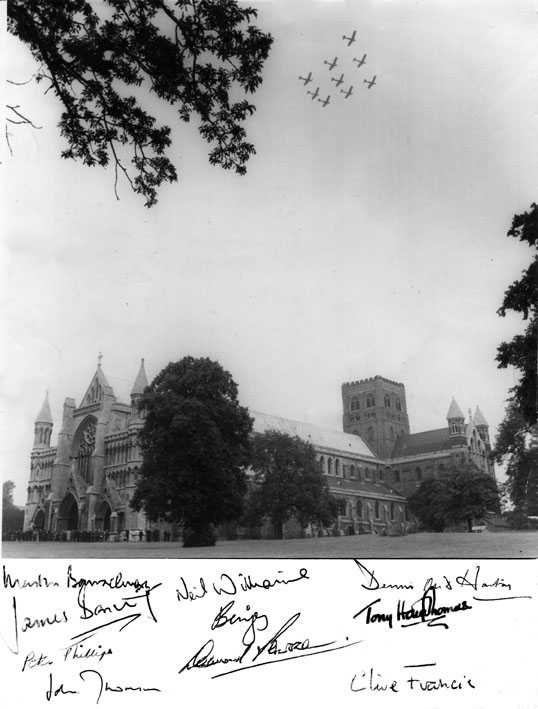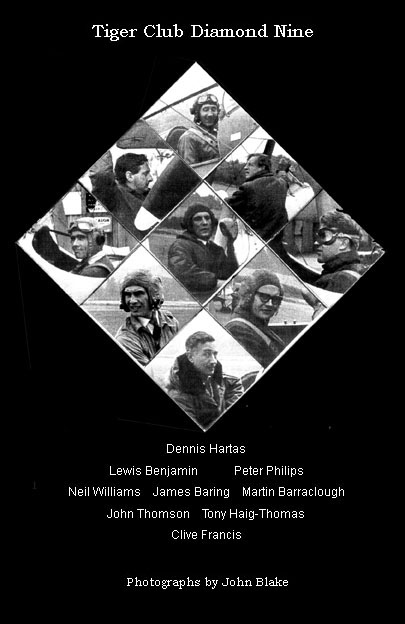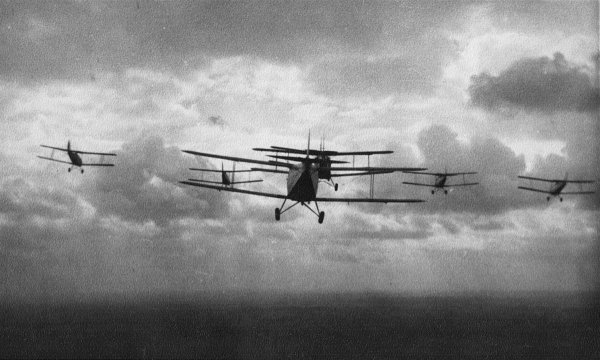


Cathedral photo by Hawker Siddeley - Press Office reference 1531OA. The 10th signature on the photo is Des Penrose of de Havilland
I am going to add here (in June 2008) the story of the memorial fly-past while it is still clear in my memory and I have John Blake and Sam Key here to help.
First, here is what appears to be a photo of us setting off from Redhill. If the owner of the photo copyright or any friend finds this page, please get in touch with me so it can be verified. It could have been taken on another occasion as the weather looks too good!
And now I look closely there are only 7 planes, not nine, and only 6 can actually be seen!

A bit about the day, and a tenth man who flew
with
us but has NOT signed the photo.
Martin Barraclough had the idea, The Royal Aero Club sponsored us with moral support.
Dennis Hartas agreed to lead us. Being a BEA pilot and familiar with the London control zone and the most experienced Tiger pilot amongst us there was no contest for that job. I decided to take the centre slot. Because Neil, Peter and I were at the time well practised together in Tiger formation aeros we knew the exaggerated effect of late power and height correction in Tigers. If the three of us held position at all times, the nine had a good chance of remaining a diamond! The day before the flight we set up several aircraft on the ground in the flying attitude, trestles under the tails, and sat everyone in their place to to ingrain the visual angles in their memories.
We had time for a brief practice flight for some but the most remarkable performance was by John Thomson who turned up at Redhill by chance on the day, not having been around previously and oblivious of the project. He took the place of Barry Tempest who had been unable to get there. The weather was too bad for Barry even to follow the 'iron beam' railway line from Headcorn. Yes, it was that bad. I had 15 minutes only to brief John on how to fly a Tiger in formation in a Diamond Nine - he only had a few hours on Tigers. But John had done about 20 hours close formation with me in Turbs round France (the subject of an amusing article penned by him at the time in the Royal Aero Club Gazette). He had RAF Cranwell training and had won the Sword of Honour. I knew he could do it.
We decided the cloud base and visibility was too bad to fly to Hatfield in any other way than packed together in the diamond nine we had planned for the fly-past. and sure enough we soon found ourselves suddenly in cloud. Dennis held steady and tried to lower us out but soon realised it was better to keep going as at least there was little or no turbulence. We continued that way till close to Hatfield, and although there were moments before that when the ground reappeared not one of us knew or cared, so riveted was our attention on keeping close formation for fear of losing sight of the man next to us.
Approaching Hatfield Dennis rocked his wings. I signalled my wingmen and box we would be throttling back and we separated the nine into a vic of 5 and a box-four. These each morphed into echelons for a break and landing and the grass. All went well until Tony Haig Thomas, positioning quite correctly, was unaware of an ILS aerial hiding on the grass to his right while he was watching the Tiger ahead just to his left. Both Tony's Tiger and the Hatfield Instrument Landing System were rendered instantly unserviceable
So there we were, with 8 Tigers to do a diamond nine fly-past. Frantic telephoning located another Tiger at nearby Panshangar. John Blake and Ken Smith flew over in the Piper SuperCub to see if it could join us. I gave my Tiger to one of the others and prepared to fly in the replacement when it arrived. John and .Ken got lost on the way back from Panshangar but the Tiger arrived flown by its owner who had only purchased it very shortly beforehand and had limited experience. There was not even time to get him out of the cockpit. All the other aircraft had engines running, waiting to taxi. So I jumped in the front and we rolled. I soon discovered the throttle friction nut in the rear cockpit was done up really tight. We had no intercom and he could not hear me. I had to develop a novel throttle moving technique as well as work out new alignment markers from the front cockpit - all very different!
We flew straight to the Cathedral and came overhead on the precise minute planned. Those of the family and congregation briefed to expect us can be seen in the photo outside. Knowing the time it takes to get people through a Cathedral doorway almost as much credit has to be given to the formation organisers on the ground as in the air.
The noise of the 9 engines from the middle of that formation (we were not wearing bone-domes or earphones) was tremendous and memorable. When we got back to Hatfield, I helped the owner of the borrowed Tiger out and apologised for not have been able to tell him what we had been about to do, or indeed speak to him at all to ask his permission to fly it or even say 'I have control'. He was just a young chap my age or younger who, I learned later, had just got a PPL. He had probably never flown anywhere near another aircraft in his life. All he said for the next minute or so was "Wow!". Apart from an ear-to-ear grin that was all we ever got out of him before he disappeared, running somewhere, I assume looking back it was to the loo. I often wonder what happened to him. I now think we ought to try and find out who he was. He really is entitled to have his signature on that photo.